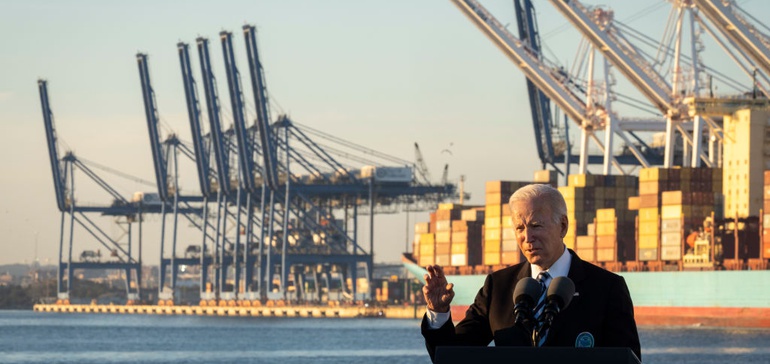Drew Angerer via Getty Images
Colin Campbell|Source: www.supplychaindive.com, November 2021
The president visited the Port of Baltimore to highlight his efforts to reduce congestion on the first stop of his infrastructure deal victory tour.
BALTIMORE — President Joe Biden boasted the shift to 24/7 operations at San Pedro Bay ports has already improved service times for container ships, using the Port of Baltimore as a backdrop to highlight his administration’s efforts to ease supply chain congestion.
The ports of Los Angeles and Long Beach, whose maritime traffic jams have become emblematic of snarled supply chains, saw a 20% reduction in the number of container ships spending more than nine days at the docks as more major shippers agreed to move cargo during off-peak hours, Biden said.
“It’s already paying off,” the president said as the sun set on a makeshift stage next to a row of bunting-decked shipping containers at the Baltimore port’s Dundalk Marine Terminal Wednesday evening.
Biden said he spoke this week with the CEOs of Walmart, UPS, FedEx and Target about concerns empty shelves headed into the holidays. All four companies pledged last month — and others have since joined them — to move more cargo during off-peak hours to alleviate congestion at the San Pedro Bay ports.
“They assured me that the shelves will be stocked in stores this holiday,” the president said.
After touring a warehouse-sized port shed with local officials and longshoremen, Biden laid out his Action Plan for American Ports and Waterways in his remarks. The near-term plan allowing ports to reallocate project cost savings toward more efficiently handling a surge in import volumes.
He touted the Georgia Port Authority’s pop-up container yards project, which is reallocating $8 million to open five pop-up container yards in Georgia and North Carolina. It will free up dock space for the Port of Savannah, which leads the U.S. in containerized agricultural exports.
“Other ports across the country will have the resources they need to make these kinds of immediate investments as well,” Biden said.
Biden’s selection of a U.S. seaport as the backdrop for the first stop of his infrastructure deal victory tour reflects its benefits — including $5.2 billion in direct funding — for ports, which handle 90% of internationally bound cargo, according to the American Association of Port Authorities.
“Ports are working around the clock to squeeze the proverbial eleventh gallon of cargo into a ten-gallon bucket — the supply chain crunch is the real-time result of deferred national investment,” AAPA CEO Chris Connor said in a statement. “Infrastructure expansion takes time, but this bill allows ports to get to work.”
The $1.2 trillion bipartisan infrastructure package contains funding for port equipment and facilities upgrades, dredging and channel maintenance, marine highways, rail needs, safety improvements and emissions-lowering projects. The deal, which Biden plans to sign Monday, also provides for “historic investments in environmental cleanup and remediation, rebuilding resilience against superstorms and droughts and wildfires and hurricanes,” Biden said.
The Port of Baltimore, which handles far more autos than containers because of its location as the farthest inland East Coast port, has benefited from the terminal congestion elsewhere, said William P. Doyle, the port’s executive director.
“Because ports were congested around the country, we’ve had 24 ad-hoc container ships come to the Port of Baltimore that were destined for other ports since July 2020,” Doyle said. “On top of that, over the past 10 weeks, we’ve attracted two new permanent services.”
Biden repeatedly thanked the Baltimore longshoremen and smiled for pictures with several of them after his speech. In urging the passage of his $1.75 trillion “Build Back Better” social and climate spending proposal, he encouraged companies to see the value in creating well-paying jobs “so when disruption hits, companies can quickly adapt because they’re invested in their workers.”
The president credited his port envoy, John Porcari, who previously served as Maryland transportation secretary under two governors, for encouraging operators, shipping companies, unions and retailers to speed commerce and keep shelves stocked for the holiday season.
“Instead of pointing fingers, we’re seeing folks start to work together: railroads, ocean liners, labor, state and local governments,” the president said. “The progress has already begun. And now we passed the Bipartisan Infrastructure Bill — the deal — it’s only going to accelerate.”

